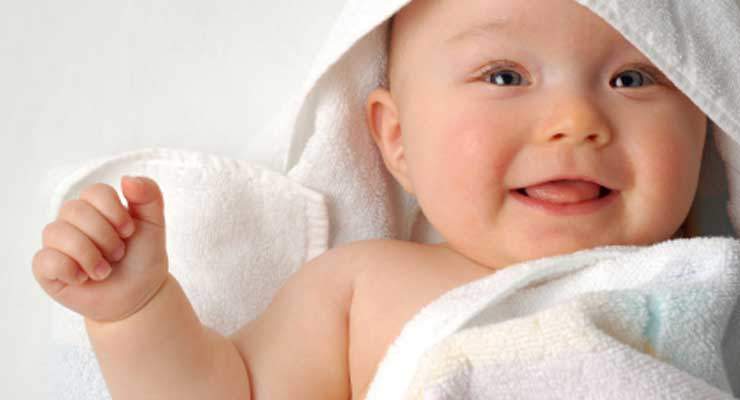We use our hands all day. As adults, we don’t even think about it on a regular basis – we just “do.”
But, when you watch your baby, you will notice that’s it has not always been this way. Actually, you can seem them as a tool that we increasingly learn to use. You see, when your baby is first born, he doesn’t even know that his hands exist, much less what they can (and wil!) do. As he grows and gets older, he starts to “discover” them, and it becomes an exercise in fascination.
We have put the developments down for you to see the progression and so you can help your little one find out what those “things” at the end of his body can do:
Two Months: Hey! One Hand! At about 8 weeks after your baby’s due date, he discovers his hands and feet. He notices those “things” atached to end of his body and you will see that he is very interested. He moves them about and they seem to be in constant motion. Also, your hands fascinate him. Some babies can already clamp a toy in one hand. There, of course, your child needs your help as he can only grasp something that fits in his hand and is very light. Naturally, at this age, you have to give it to him. Suggestion: Good things to try at this age are light rattles or plastic rings.
Three Months: Grabby, Grabby! Twelve weeks after his due date, your baby is the master of the grab. In fact, be careful, as he gets the hang of grabbing things directly at this age, and will try it every chance he gets. In order to master this, though, he needs to take the next little jump forward. At this stage, help your baby learn to “take.” Give him something so that it’s not too difficult for him, but also not too easy. And, when it works, you must give him hundreds of compliments!
Four-and-a-Half Months: Wild Scrabble: Of course, at this age, babies don’t actually play Scrabble, but it suits them from a developmental perspective and they certainly have fun trying! They like the rummaging around of everything around them to find and pick things up. Many mothers start this now, slowly enough for their baby, and instructing their little ones about the differences between wildly grabbing and picking things up. The “wild scrabble” is just a way for your baby to explore the world.
Six Months: Realizing That His Hands are “Real Things”: Six months on, your baby realizes that his hands are “real things” and can do some really interesting stuff. By now, he has become quite skilled in grabbing things – quickly and firmly, He can open and shut a book by himself (you likely experienced this while trying tor read to him), and is using his hands to discover his new passion of “in,” “on,” “under” and “above.” Because he took the “leap of relationships” at this age, he is interested in the distances and proportions of things together, moving something somewhere to stop things alongside one another, to put something in another spot and so on. It can go one forever! He realizes that his hands actually have the same purpose as yours do: to do “stuff.” Now, they have a purpose!
Eleven Months: From Hazard to Loads of Fun! Once your baby turns 11 months old, and the “leap of sequences” has taken place, he was particularly interested in singing and movement game, such as “clap hands once, happy, happy, happy” and the like. But be aware, because your baby can now not only have fun with his hands, but he can also face dangers! Remember, not only has he discovered them, but he’s also gained strength and developed a grip! At 11 months, your baby is curious about everything around him and increasingly mobile. So, while he may (almost) understand some things may be dodgy, he will grab at everything he can and will not know what the consequences may be. For now, socket quards to protect little ones are so important!
One-and-a-Half Years: No More Spills and Some Beautiful Artwork: Let your child “make” and “do” more and more at this age so that he can practice his hand movements. You will find that he really is able to pick himself a snack and drink from his cup without spilling. He can also now be turning the pages of a book on his own. He will love to make and give you beautiful drawings. Encourage this by giving him pencils, paintbrushes and special “child” pens that are slightly thicker than normal for easy gripping. Plus, the child-friendly art supplies are easily washable in case they wind up somewhere they shouldn’t.
Two Years: The Small Hand Muscles and Big Towers: Your baby is now well familiar with what his hands can do, and now he needs to work those muscles. Blocks. such as Legos, encourage him greatly, as it is all about putting the blocks together correctly and then pushing down to “lock.” Particularly the latter part, as the motion exercises the small hand muscles. With a little practice, he builds bigger and bigger towers with his blocks. The best part? The compliments…and the collapse of the tower!
Three Years: Knots and Cutting! Your child uses his hands more and more like we, adults, do and they are used for the same things. With a little practice, he can even do the buttons on his clothes and learn to untie things. As always, encourage him to to as much as he can himself. As a result, his confidence will grow! He is now making a HUGE leap in hand muscle development. Give him a pair of child-friendly scissors to cut things. This is not only fun for him, but it also stimulates the hand muscle development even further!
Left or Right Handed? Once it was thought to be better to be right-handed rather than left-handed. At schools, writing with the right was “right,” so to speak, and obligitory. Now, fortunately, we know better. As a parent, you do not affect which hand is dominant when it comes to your child. In fact, if your left handed child is “forced” to be right handed, you increase the liklihood of stuttering and psychological problems. If you and your partner are left handed, there is three times the chance that your little one will be the same. You will also notice that as your baby learns more about his hands, he will often switch between left and right – sometimes he will be left handed, and sometimes right handed. At some point, you will notice that he has a preferred hand, which will remain his preferred hand for life.





